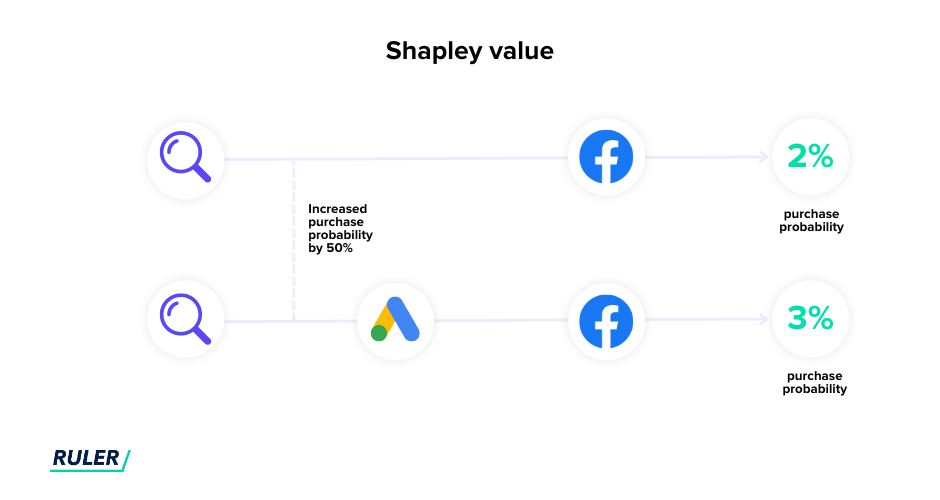Leverage view-through attribution for a comprehensive picture of what is and isn’t working.
Measuring the impact of ads and brand campaigns is tough, which is likely why exploring view-through attribution is on your radar.
The modern customer journey is a complex labyrinth, making it challenging to measure and prove the value of upper-funnel marketing initiatives like brand awareness campaigns and display ads.
This can lead to difficulty in allocating budget effectively and demonstrating ROI.
Fortunately, sophisticated attribution models such as view-through attribution (VTA) can help bridge the gap between impressions and tangible results like revenue generation, which is precisely what this guide will cover.
Here’s what you’ll learn:
💡 Pro Tip
As third-party cookies crumble, traditional view-through attribution in platforms like Meta becomes increasingly untrustworthy. Ruler’s impression attribution, fueled by machine learning, analyses website traffic patterns to pinpoint the true influence of your ads on conversions and revenue, even weeks after impressions occur.
Book a demo to explore Ruler and secure your future attribution strategy today.
View-through attribution (VTA) assigns credit for conversions, such as sales or leads, to ad impressions, even if users don’t click on the ad itself.

This approach acknowledges that ad exposure can influence user behaviour, even if they don’t interact directly with the ad.
VTA works by establishing a timeframe (often 24 hours to 7 days) after an ad impression. If a user converts within this window, regardless of whether they clicked the ad, the conversion is attributed to the ad campaign that served the initial impression.
For reference, here’s a quick overview of different view-through attribution windows offered by popular advertising platforms:
With view-through attribution understood, let’s explore how click-through attribution works and how it differs.
In contrast to view-through attribution, which considers ad impressions, click-through attribution focuses solely on direct user clicks on an advertisement.
If a user clicks on your ad and subsequently converts (completes a desired action), all credit is attributed to the clicked ad.
Just like view-through and click-through attribution have different meanings, they both have different strengths, which we’ll explore in more detail.
Let’s first explore the notable strengths of view-through attribution:
Now, let’s centre our focus on the click-through attribution.
💡 Pro Tip: While view-through attribution in platforms like Meta is changing, impression tracking remains alive and well. Skip to the next section to explore alternative solutions for impression tracking.
It’s crucial to understand that view-through attribution isn’t a replacement for click-through attribution, and vice versa.
Instead, these two methods work best in tandem, offering a comprehensive picture of your advertising performance.
Consider a real-world scenario:
Let’s say a user searches for ‘best white trainers’ on Google search. They find your website in the organic results, browse your collection, and leave without making a purchase.
Later that day, they see your Instagram ad, return via direct search, and buy those trainers.
Three weeks later, they see a Facebook retargeting ad (but don’t click) and return via direct search to make another purchase.

While traditional click-through attribution tools would capture the direct and organic search clicks and link them to purchases, they miss the potential impact of the Instagram and Facebook ads that the user viewed.
View-through attribution, however, would account for these ad views, allowing you to compare data from both models and assess the complete impact of your various marketing touchpoints.
If you’ve made it this far, you get why view-through attribution matters.
The key now is doing it right.
While most ad platforms offer view-through attribution to track conversions (like purchases) influenced by ad impressions, it’s important to consider their limitations.
Leading ad platforms typically credit conversions solely to ad impressions viewed within a short window (1-7 days).
This approach neglects the reality that, especially in B2B situations, buying decisions often span longer timeframes.
As a result, valuable influence from ads is often misattributed to other channels, like search or direct, when the conversion ultimately occurs.
Further complicating the matter, the increasing downfall of third-party cookies throws a wrench into VTA’s functionality.
As third-party cookies are crucial for tracking user journeys across platforms, their inconsistency will significantly limit the ability to accurately identify the impact of ad impressions on conversions inside the standard attribution window.
These limitations highlight the need for alternative methods that comprehensively assess marketing’s impact on revenue, capturing both impressions and clicks.
By moving beyond the limitations of in-platform attribution, tools like Ruler provide a more comprehensive view of campaign performance.
Ruler utilises sophisticated click attribution to track the entire click path journey, allowing you to pinpoint the exact sequence of channels, ads, campaigns, and landing pages that contribute to a conversion or revenue.

But it gets even better. Ruler uses advanced machine learning to track ad impressions.
It uses Bayesian statistics to develop algorithms that match ad impressions with eventual conversions and revenue.
Once impressions are matched to conversions, Ruler utilises Shapley Regression to distribute credit.

By combining the power of click and impression attribution, you can:
Don’t underestimate the power of impressions.
Clicks get the spotlight, but impressions are essential for understanding the complete customer journey. By giving credit to both clicks and impressions that lead to conversions, you gain a richer picture of your marketing’s effectiveness.
Traditional ad platforms are losing their view-through tracking abilities due to changing privacy regulations.
But Ruler empowers you with the tools you need to track and attribute clicks and impressions to revenue, giving you the accurate insights you need to maximise your marketing ROI.
Book a demo today and discover how Ruler can help you optimise your marketing spend and drive business growth.
